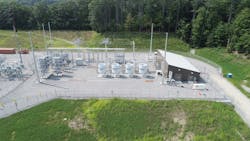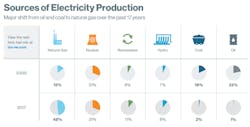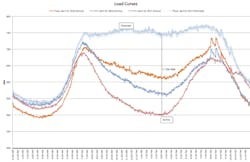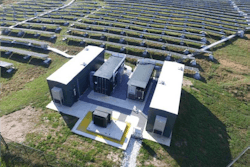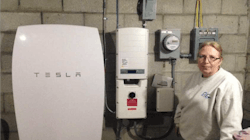Challenges of an Evolving Electric Grid
Changes in the way we produce, store, manage, and use electricity are transforming the way the electric power industry operates the grid. Among the key trends are retiring base-load power plants, increased distributed generation, rising investment in energy efficiency and demand response, and technological innovation in heat pumps, electric vehicles (EVs) and storage. This paper outlines the challenges grid operators face as we manage grid reliability in a rapidly evolving environment.
Challenge 1 — Dependence on Natural Gas for Electric Generation
In 2000, New England produced 40% of its electricity from coal and oil, and 30% from natural gas and renewables (including hydro). By 2017, 67% of the region’s electricity came from natural gas (48%) and renewables (15%), and only 3% from coal and oil. Driven by economics and public policy, this trend continues, with more than 5000 MW of fossil-fuel generation retired or intending to retire.
The region’s high reliance on natural gas poses a particularly significant challenge. On days of low solar and wind production, natural gas-fired generation supplies more than 60% of our power. Because of limited pipeline capacity and few delivery points for liquefied natural gas (LNG) into the region, fuel availability to electric generators is constrained on the coldest days when firm supply goes first to space heating. On the same days, snow and short days typically limit solar production, an increasing component of the region’s supply. At the same time, pipeline construction proposals have met with powerful resistance from potential host communities and environmental advocates concerned about climate change making increased pipeline capacity an unlikely fix.
ISO New England, the regional transmission authority, is treating this issue with high urgency, leading stakeholders in the development and ultimate approval by the Federal Energy Regulatory Commission (FERC) of several market changes, such as pay-for-performance and competitive auctions with sponsored resources (CASPR) designed to ensure winter reliability. The likelihood of further aging power plant closures mean that New England will continue to need solutions that meet peak demand and solve natural gas infrastructure constraints.
Challenge 2 — Renewable Integration
State policy goals, federal incentives, and falling prices are driving rapid expansion of renewable energy. More than 2000 MW of renewable generation is interconnected to the New England grid, with many more megawatts proposed, permitted, or under construction. In 2018, Vermont’s grid included 350 MW of installed photovoltaic (PV) generation, 150 MW of wind, and 120 MW of hydro power — contributing to more than 50% of the native peak load. Distributed generation provides clear economic, environmental, and resilience benefits. High renewable penetration also poses challenges to operation of a grid originally designed to rely on large baseload resource to balance supply and demand on the grid.
To increase the output and predictability of these weather-dependent wind and solar generators, utilities and developers are investing in advanced weather forecasting tools. For example, in 2012, VELCO partnered with IBM to create the Vermont Weather Analytics Center to develop highly sophisticated analytical tools that integrate load data, generation, and cutting-edge weather prediction. This effort, which began as a research-and-development (R&D) project, led to the creation in 2017 of a new energy analytics company called Utopus Insights. This work demonstrates the kind of advanced tools utilities will need to employ to ensure reliability and efficiency as more megawatts of intermittent resource connect to the grid.
In addition to the challenge of intermittency, transmission grid operators lack visibility of much installed solar generation. Except for large solar farms, much solar generation is interconnected at the local distribution level and, therefore, is invisible to transmission system operators in real time. System operators can only monitor the net load. Without real-time data on this so-called “behind the meter” generation, operators cannot know what to expect in the case of a disturbance. If generation suddenly trips off line, contingency analysis simulations may under-predict the resulting load levels coming onto the system.
The power industry and its partners are developing better predictive tools based on production data from intermittent generators even as installed renewable capacity is growing. In addition, recent changes to interconnection standards (IEEE 1547) will require updated “ride-through” and voltage control capabilities even for smaller inverter-based installations, which will keep these resources online through minor perturbations of the grid. This is no doubt just the beginning of many adaptions that will be needed to adapt to an increasingly distributed grid.
Challenge 3 — Changing Daily Load Curves
High renewable penetration has fundamentally changed the timing of daily peaks. Traditionally, load peaked around 2 p.m. when commercial energy demand reached its highest point. Today load peaks after sundown.
More critical to grid operators, the daily load shape changes dramatically on sunny days, as shown in Figure 2. This is the infamous “duck curve.” Where loads used to ramp up in the morning, peak in mid-afternoon, and drop gradually, on a sunny day, mid-day loads drop to the bottom of the duck’s belly, and then rise to their daily peak when the sun goes down.
The growth of this trend over time clearly indicates the dramatic rise in solar generation over the past several years, as shown in Figure 3.
The steep ramp in demand at the end of the day when the sun sets challenges operators to quickly increase energy production to replace the contribution supplied by PV during the day. The trick is to ensure enough generation to supply the load, but not be so conservative as to pay for generation that is not used.
Figure 2 also demonstrates the increasing importance of weather forecasting in predicting the daily load, even in the face of New England’s notoriously unpredictable weather.
Even though we always expect the unexpected, some grid behavior still has the ability to surprise operators. On April 23, 2018, the 2:30 p.m. load was lower than the 2 a.m. load, a first in the northeast prior to that day, and now a regular occurrence during high solar production days in spring when hydro plants are also running full tilt.
Challenge 4 — Voltage Control
Voltage regulation is a critical aspect of utility reliability. State regulations require all utilities to maintain steady state voltage with set limits, which has traditionally been achieved using capacitors, load tap changers on substation transformers, capacitors on lines and in substations, and circuit tap voltage regulators on lines. These all are relatively slow-acting methods of voltage control. Today, solid state inverters, which are features of most renewable generation, technically allow quick voltage adjustments if the capability is used.
IEEE Standard 1547 was modified in 2018 to allow utilities to set interconnection requirements for distributed resources’ behavior in a disturbance, as well as for voltage regulation, VAR generation, and other factors. Often, high levels of distributed generation can cause high voltage at the distribution substations as utility devices struggle to control voltage under low loads. The changes in IEEE 1547 give distribution utilities the authority they needed to address voltage and ride-through issues raised by large amounts of inverter-based generation, but utilities must now take the next step; they must adapt their interconnection rules to implement this authority. Only then will distributed generation installers have the criteria and settings to work smoothly with the existing utility voltage control strategies.
Similar issues can arise on the transmission system. Because of the topology of the Vermont transmission system, voltage control is a significant issue, which we address by deploying several technologies including switched capacitors, phase shifting transformers to limit flows, synchronous condensers for fault current sources, voltage control and VAR management, switchable shunt reactors, a static synchronous compensator (STATCOM), and a static var compensator (SVC). Figure 3 is a picture of a SVC connected to the 115-kV system in Vermont.
With the challenges of controlling voltages in this new environment, utilities can make good use of non-utility owned, inverter-based generation to assist in the control of voltages to all customers. Additionally, utilities will have to turn to faster voltage controlling technologies to keep voltages steady. Failure to make these changes threatens power quality for customers.
Challenge 5 — Evolution and Growth of Storage
Many different battery technologies are being developed and deployed today. Although today’s costs that are still relatively high, like most emerging technologies, costs are likely to drop over time, and storage will likely become a significant part of our energy future.
The characteristics of the various battery storage options, and therefore their value streams, vary greatly. Some batteries achieve high output for a short duration; others are more effective for large amounts of storage delivered over a long time. Some technologies are readily available today, while others are still in the R&D phase.
Vermont’s largest distribution utility, Green Mountain Power, has invested heavily in storage as part of its plan to reduce system peaks, and increase distributed energy and system resilience. GMP is working at both the utility scale and customer ends of the spectrum. Figure 5 shows the utility’s 4-MWh battery system installed in Rutland, Vermont, at their Stafford Hill Solar facility.
For individual customers, GMP is offering 2000 Tesla Powerwalls to customers within its service territory. For US$15 a month for 10 years, or a one-time payment of US$1500, GMP and Tesla install a Powerwall battery in the customer’s home, providing backup power during grid outages. In exchange, participating customers agree to allow GMP to share access to the Powerwall in order to reduce peak energy costs.
Challenge 6 — What Will the Electric Load Do in the Future?
Electric system planning relies on forecasts of future demand for electricity as a critical input. In the past, this task was reasonably straightforward; it used the past to predict the future. For example, forecasters typically used 10- or 20-year temperature data for load forecasting and assumed that demand would vary with temperature in much the same way as it had historically. Similarly, economic growth traditionally had a direct predictive relationship to load growth.
Much of this past predictability has been turned on its head with changing trends in economic growth, technology, regulation, weather, and many other factors, as well as a decoupling of economic and load growth. These changes are significantly transforming electric use and the way we plan for the future.
Many states have implemented clean energy policy goals to combat climate change by electrifying transportation and heating, and establishing requirements for electric utilities to source an increasing portion of their power from renewable, carbon-free sources. These “beneficial electrification” policies promise to reduce carbon emissions from transportation and heating, and to help states that have established goals such as Vermont’s objective of a 90% reduction in carbon emissions by 2050. Other states in New England have adopted similar goals.
Beneficial electrification will likely increase electric use significantly over time. Some EV fast chargers can use as much energy as the rest of a small residential home at peak. Although last year only 2.4% of new cars sold were EVs or plug-in hybrids, this represented significant growth from 2017. Although internal combustion engines may continue to predominate, the potential electric load increase from even modest EV growth will require careful planning and new demand control strategies to ensure smooth grid operations and to avoid unintended increases in peak loads.
Cold climate heat pump deployment has the potential to reduce the reliance on fossil-based heating fuels in northern climates. At the same time, electrifying space heating promises to increase electric demand. Heat pump technology has evolved in recent years, enabling the equipment to perform efficiently in cold climates. These systems can be readily retrofitted into existing homes and have the additional benefit of providing air conditioning in the summer.
Summary
Many interesting technical challenges face today’s electric power industry. The industry is seeking — and finding — creative solutions to the uncertainties ahead. The transition is providing exciting opportunities for partnerships with inventors, innovators, and entrepreneurs to develop solutions that could not have been conceived of even a few years ago.
Unknowns such as electrification of transportation and heating will have a major impact on demand, as will the continued growth of distributed energy. Storage will be a key part of the solution, even though it is a time-shifter, not an addition of new energy and its growth will be limited until costs come down.
It is an exciting time to be in the industry. Electricity is and will continue to be essential to today’s society and will have a valuable contribution to the climate change solution.
About the Author
Christopher E. Root
Christopher E. Root is a COO of Vermont Electric Power Company.
